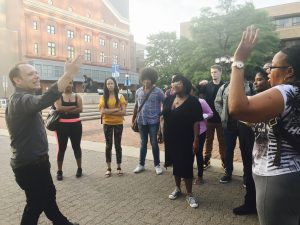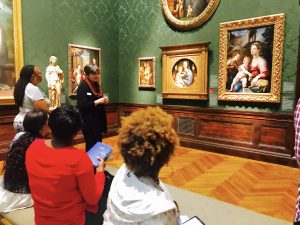You’ve probably heard the term ‘experiential learning’ and thought, “What does that mean exactly?” Experiential learning is essentially learning by doing. It means, you get out of the classroom and into the real world to put your knowledge into practice through hands-on experiences. And this semester’s Arts 304 course, co-taught by Assistant Professor Ian Power and Assistant Professor Rachael Zeleny, is doing just that.
Arts 304—better known as ‘Arts and Ideas’—is described as an interdisciplinary study of enduring works of imagination and intellect that have contributed to the making of contemporary civilization. The course uses examples of art, architecture and music to illuminate central themes in literature, philosophy and history, and the cultural resources of the Baltimore area are utilized wherever appropriate.
For their spring course, Professors Power and Zeleny are having their students visit some of the city’s most amazing and well-known arts and culture institutions, including the Walters Art Gallery, the Peabody Institute, the American Visionary Art Museum, the Reginald F. Lewis Museum, and the National Great Blacks in Wax Museum. The students also went on a historic ghost tour in the city. Sixty percent of the class time is spent outside of the classroom. The course also brings an array of guest artists, musicians, and poets into the classroom to not only perform for the students but also explain the context and purpose for their work.
Each week, a different student serves as the designated class photographer/blogger, and he or she is responsible for documenting that week’s guest speaker or out-of-class adventure as a blog post featured on Prof. Zeleny’s website. And for their final project, the students will curate an “art tour” that looks at Baltimore through a specific lens. For example, they might choose a jazz tour of Baltimore that could include a restaurant like Sotto Sopra, an outdoor concert, an exhibit at the Peabody, and the home of Billie Holiday.
“UB sits in the heart of Baltimore’s culture and history but so many of our students have only been inside the classroom,” said Prof. Zeleny. “This class is trying to change that, to encourage our students to pause before walking past a building or a piece of art, to feel that they deserve to ask the question, ‘why is this important?’ I want them to feel empowered to say they are a part of this city and not just passing through.”
By the end of the semester, Profs. Power and Zeleny hope that as a result of their experiences both in and out of the classroom, the students will have greater empathy for the various experiences of those who lived before us and for our unique and diverse student body.
To read more about Arts 304, check out “If a Tour Guide, a Slam Poet and a Curator walked into the Owl Bar: Baltimore’s Classroom” written by Prof. Zeleny for the April 2018 issue of the UB Post (available now at newsstands all around campus).


